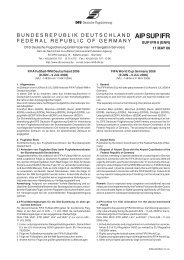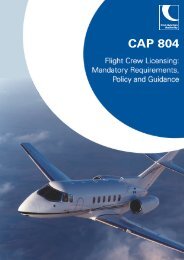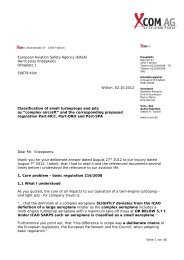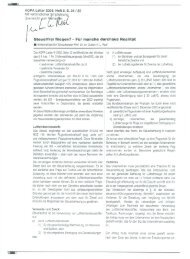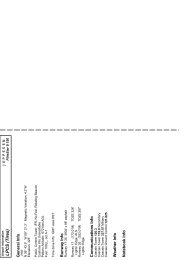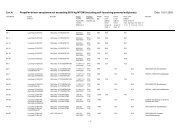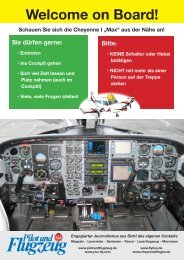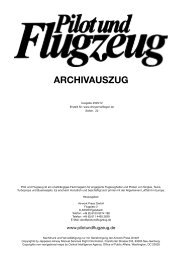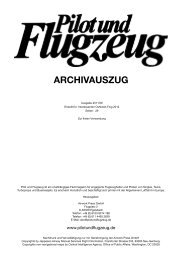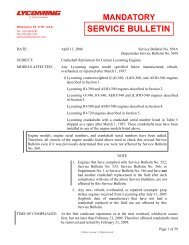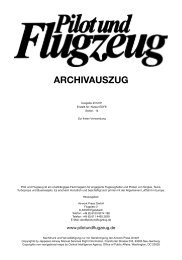The International Comanche Society - Pilot und Flugzeug
The International Comanche Society - Pilot und Flugzeug
The International Comanche Society - Pilot und Flugzeug
Create successful ePaper yourself
Turn your PDF publications into a flip-book with our unique Google optimized e-Paper software.
<strong>Comanche</strong> served in the late 1980s.<br />
We’re now in the business of organizing<br />
an intercontinental trip (called<br />
“Leserreise”) every two years for people<br />
who wish to fly their high-performance<br />
general aviation airplanes to remote<br />
locations such as Alaska, Australia or<br />
South Africa.<br />
We do this mostly for the PR that<br />
comes with it and – let’s be honest – for<br />
the heck of it! Our job: Organizing the<br />
trip! This means basically flying the<br />
intended route a few months in advance<br />
to scout out all the problems and issues,<br />
sort them out, make sure Avgas is available<br />
and repeat the thing with a flock<br />
of 10-15 airplanes a few months later.<br />
<strong>The</strong> average airplane on these trips<br />
is a cabin class twin or turboprop. Let’s<br />
say a 340, ranging up to a PC12 or a<br />
Cheyenne III. <strong>The</strong>re’re also Turbo-<br />
Mooneys and Senecas in the crowd, but<br />
our Twin <strong>Comanche</strong> is definitely on the<br />
lower end of the performance envelope.<br />
Here is what I’ve learned: While<br />
11Y is already serving us well for our<br />
regular business trips within Europe<br />
(300 – 1,000 NM), this girl can do so<br />
much more! Outfitted with tip- and<br />
nacelle-tanks its range (140 USG) and<br />
speed (170-190 KTAS) make it a true<br />
globetrotter!<br />
So in early 2005 a coworker and me<br />
set out to prepare the 2005 “Leserreise”<br />
– a trip all the way from Europe to China,<br />
stopping in Iran, Pakistan, India, Nepal,<br />
Thailand and Laos on the way east; and<br />
in Cambodia, India, Oman, Bahrain<br />
and Jordan on the way back.<br />
To cut a long story short, 11Y did<br />
just great! All the way from the hotand-high<br />
conditions of Iran, the extreme<br />
environment in the Himalaya to the<br />
jungle of Laos and Cambodia, the Twin<br />
flew wonderfully.<br />
<strong>The</strong>re were problems with SAP-<br />
Millennium cylinders installed during<br />
engine overhaul a few months earlier,<br />
causing us to stop in Amman, Jordan<br />
for maintenance, but they were sorted<br />
out. Let me say that I’m flying Lycoming<br />
cylinders now and the costs were picked<br />
up by Superior.<br />
On the actual main-trip in late 2005,<br />
when the group was with us, 11Y did<br />
marvelously again! Way faster than the<br />
Senecas in the group, equally fuel efficient<br />
than the Mooney M20M and with<br />
a better load carrying capability (on<br />
ultra long range trips of 1,000+ NM),<br />
than even the Cessna 340; the Twin Co<br />
proved all the reasons why I had initially<br />
spent my last penny on that design.<br />
One example: On a flight from Taipei,<br />
Taiwan (RCTP) to Siem Reap, Cambodia<br />
(VDSR), N7311Y flew 1,211 NM across<br />
the South China Sea and Vietnam with<br />
140 USG fuel on board in spite of constant<br />
headwinds, arriving with more<br />
than 90 minutes of fuel left!<br />
A Cheyenne IIIa, flying the same<br />
route as part of our group, had to divert<br />
to Hong Kong for fuel. It has to be said<br />
for fairness, that while we had on average<br />
5-10 KTS headwind down low, the<br />
Turboprop was faced with 20-30 KTS<br />
at altitude, but it <strong>und</strong>erlines the versatility<br />
of the PA30 to be able to fly<br />
fuel efficient in a wide range of altitude<br />
levels.<br />
Many of the larger Twins (C303, C340,<br />
Seneca) did not even attempt the flight<br />
on that day. On these ultra-long-range<br />
challenges, the Twin Co was only second<br />
to the powerful PC12 and a highly<br />
modified Turbine-Bonanza.<br />
(All the events and impressions from<br />
these two flights to the Far East would<br />
prove too much for this column, but I<br />
have assured Kim that we could feature<br />
the trip in future Flyers.)<br />
Flying across the globe of course is<br />
the exception. On a daily basis 11Y flies<br />
for business, carrying me and/or staff<br />
members on an average of 200-500 NM<br />
trips throughout Europe.<br />
And N7311Y – affectionately christened<br />
“Gretchen” by a good friend of<br />
mine from New York – has come a long<br />
EDM engine monitor,<br />
Approach-GPS,<br />
large Moving Map<br />
(MT Vision Air). <strong>The</strong><br />
cockpit of 11Y is a<br />
workplace, not so<br />
much an avionics<br />
showroom. However,<br />
the airplane has to<br />
perform reliably and<br />
economically<br />
for business….<br />
...and for pleasure!<br />
Arriving at Endelave,<br />
a beautiful island on<br />
Denmark for a<br />
weekand getaway.<br />
way since its days as a basic cloudseeder<br />
in Fargo, N.D. It now has a modern<br />
panel layout, a basic (but clean)<br />
new interior, an approach-certified GPS,<br />
the STEC-30 two axis autopilot, a large<br />
moving map (MT Vision Air) including<br />
WX-uplink, realtime ATC-flight plan<br />
submission, Terrain Warning and WX-<br />
500 Stormscope display, backup gyros,<br />
an engine overhaul, nacelle tanks, tip<br />
tanks, alternators, lightweight starters<br />
and finally last winter a new paint job!<br />
Flying now aro<strong>und</strong> 200 hours a year<br />
mostly for business, I’m planning to get<br />
many more hours out of this exceptional<br />
aircraft.<br />
What I value most about the Turbo<br />
PA30 is the versatility of the design.<br />
While it’s an airplane that you can fairly<br />
easily circumnavigate the globe with,<br />
you can also take off from your favorite<br />
500-meter (1,600-foot) grass strip near<br />
the beach and fly with four people and<br />
enough fuel on board to go 500 NM.<br />
It’s giving you Bonanza-like fuel efficiency<br />
and almost the load hauling<br />
characteristics of a C210. All that at<br />
twin engine safety and (for turbo PA30s)<br />
a single engine service ceiling well<br />
above Europe’s highest mountains or<br />
Greenland’s dreaded icecap.<br />
Even when comparing it to newer<br />
designs such as the DA42 (which we<br />
tested intensively) it’s simply the best<br />
light twin design on the market as<br />
long as you don’t require the pressurized<br />
cabin.<br />
Jan Brill, born November 5, 1974 is<br />
managing editor of <strong>Pilot</strong> <strong>und</strong> <strong>Flugzeug</strong>,<br />
Germany’s leading general aviation magazine:<br />
www.pilot<strong>und</strong>flugzeug.de. You can<br />
contact him at jan.brill@pilot<strong>und</strong>flugzeug.de<br />
SEPTEMBER 2006





